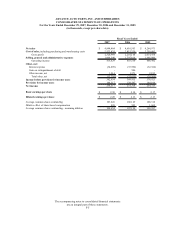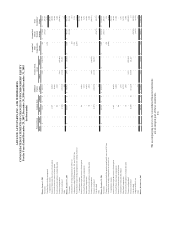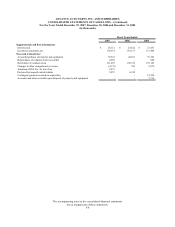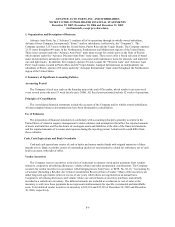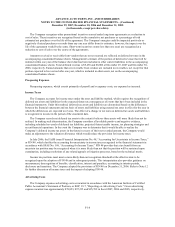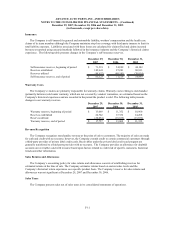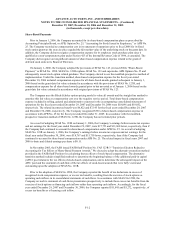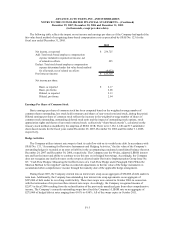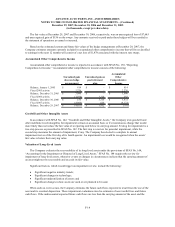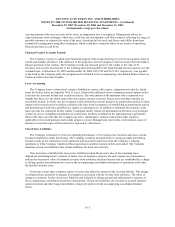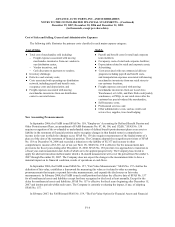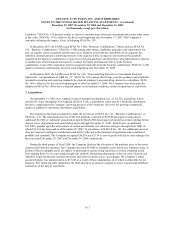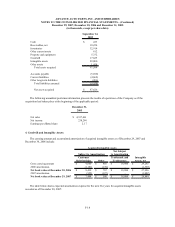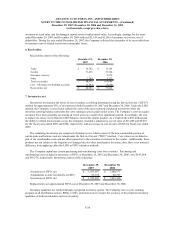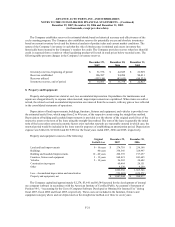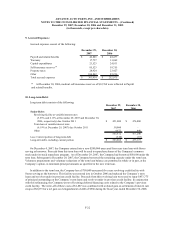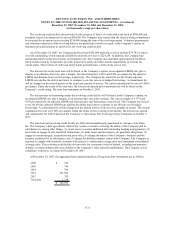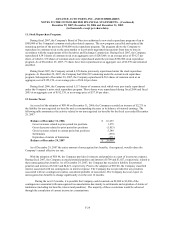Advance Auto Parts 2007 Annual Report Download - page 73
Download and view the complete annual report
Please find page 73 of the 2007 Advance Auto Parts annual report below. You can navigate through the pages in the report by either clicking on the pages listed below, or by using the keyword search tool below to find specific information within the annual report.
ADVANCE AUTO PARTS, INC. AND SUBSIDIARIES
NOTES TO THE CONSOLIDATED FINANCIAL STATEMENTS – (Continued)
December 29, 2007, December 30, 2006 and December 31, 2005
(in thousands, except per share data)
The fair value at December 29, 2007 and December 30, 2006, respectively, was an unrecognized loss of $7,645
and unrecognized gain of $156 on the swaps. Any amounts received or paid under these hedges will be recorded in
the statement of operations as earned or incurred.
Based on the estimated current and future fair values of the hedge arrangements at December 29, 2007, the
Company estimates amounts currently included in accumulated other comprehensive income that will be reclassified
to earnings in the next 12 months will consist of a net loss of $1,478 associated with the interest rate swaps.
Accumulated Other Comprehensive Income
Accumulated other comprehensive income is reported in accordance with SFAS No. 130, “Reporting
Comprehensive Income.” Accumulated other comprehensive income consists of the following:
Unrealized gain
(loss) on hedge
arrangement
Unrealized gain on
postretirement
plan
Accumulated
Other
Comprehensive
Income
Balance, January 1, 2005 814$ -$ 814$
Fiscal 2005 activity 2,276 - 2,276
Balance, December 31, 2005 3,090$ -$ 3,090$
Fiscal 2006 activity (2,934) 3,316 382
Balance, December 30, 2006 156$ 3,316$ 3,472$
Fiscal 2007 activity (4,809) 636 (4,173)
Balance, December 29, 2007 (4,653)$ 3,952$ (701)$
Goodwill and Other Intangible Assets
In accordance with SFAS No. 142, “Goodwill and Other Intangible Assets,” the Company tests goodwill and
other indefinite-lived intangibles for impairment at least on an annual basis or if circumstances change that would
more likely than not reduce the fair value of a reporting unit below its carrying amount. Testing for impairment is a
two-step process as prescribed in SFAS No. 142. The first step is a review for potential impairment, while the
second step measures the amount of impairment, if any. The Company has elected to complete its annual
impairment test as of the first day of its fourth quarter. An impairment loss would be recognized when the assets’
fair value is below their carrying value.
Valuation of Long-Lived Assets
The Company evaluates the recoverability of its long-lived assets under the provisions of SFAS No. 144,
“Accounting for the Impairment or Disposal of Long-Lived Assets.” SFAS No. 144 requires the review for
impairment of long-lived assets, whenever events or changes in circumstances indicate that the carrying amount of
an asset might not be recoverable and exceeds its fair value.
Significant factors, which would trigger an impairment review, include the following:
xSignificant negative industry trends;
xSignificant changes in technology;
xSignificant underutilization of assets; and
xSignificant changes in how assets are used or are planned to be used.
When such an event occurs, the Company estimates the future cash flows expected to result from the use of the
asset and its eventual disposition. These impairment evaluations involve estimates of asset useful lives and future
cash flows. If the undiscounted expected future cash flows are less than the carrying amount of the asset and the
F-14



